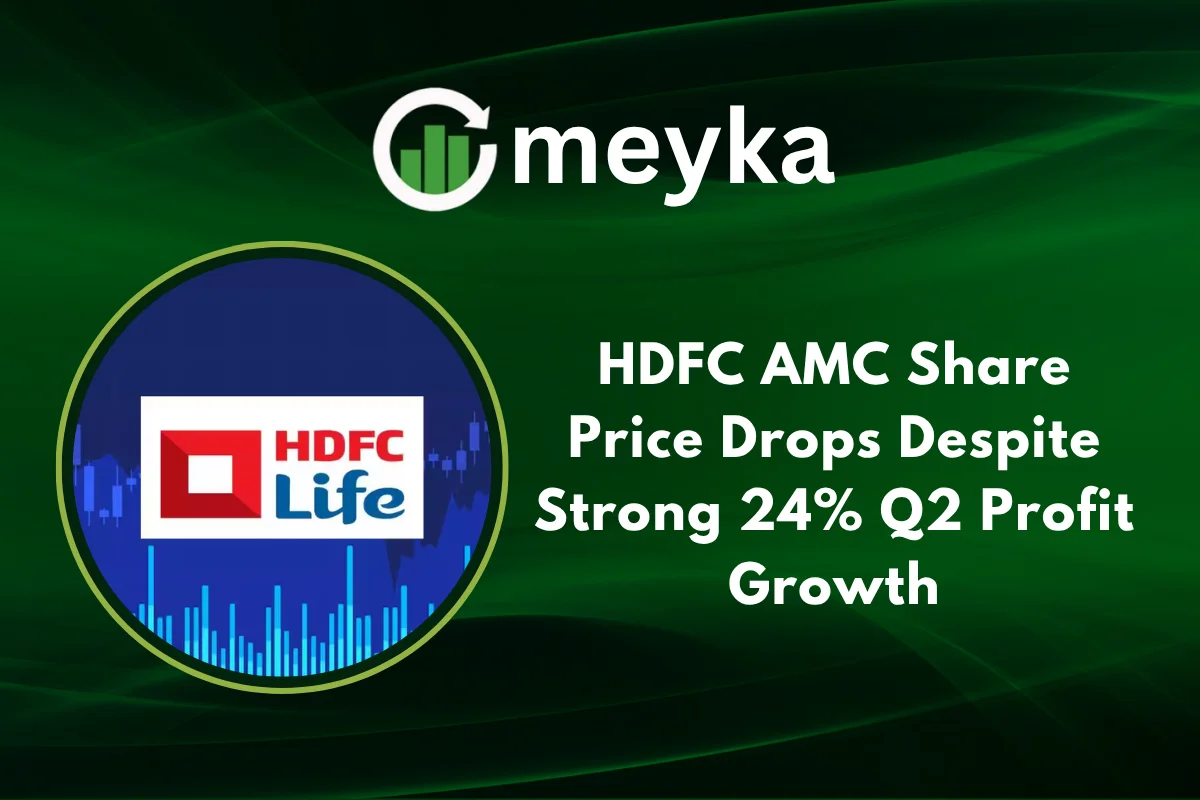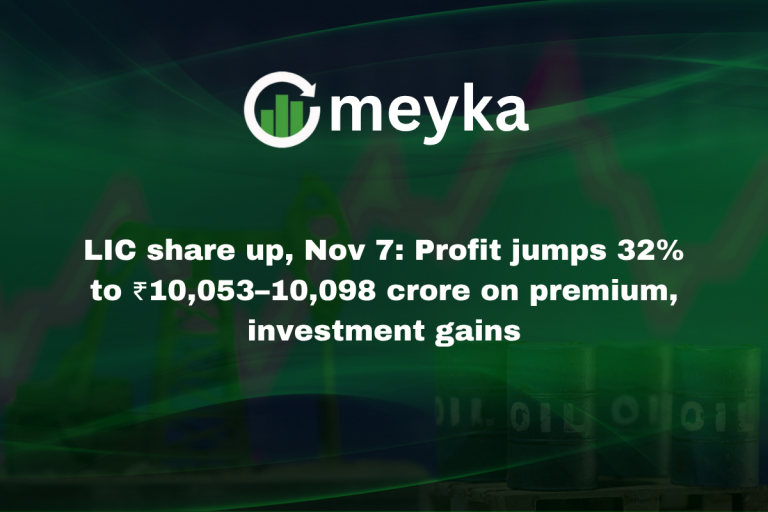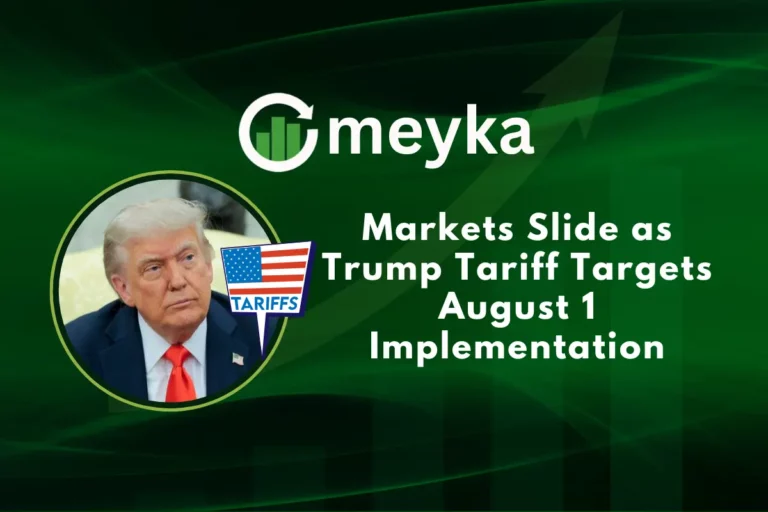HDFC AMC Share Price Drops Despite Strong 24% Q2 Profit Growth
In a surprising development for investors, HDFC AMC share value fell even though the company reported a robust 24 % year-on-year profit growth in Q2 FY26. We examine the underlying figures, the market reaction, and what this might mean for the future performance of this key player in the Indian asset management space.
Q2 Performance: Profit Soars, But Price Falls
In the quarter ending September 2025, HDFC Asset Management Company (HDFC AMC) posted a net profit after tax (PAT) of ₹718.4 crore, up about 24.6 % compared to ₹576.6 crore in the same quarter last year.
Revenue from operations also grew, reaching around ₹1,027.4 crore, up roughly 15.8 % YoY (versus ₹887.2 crore a year ago).
Assets under management (AUM) remain a core metric for AMC stocks. For Q2, HDFC AMC’s AUM expanded ~14 % YoY to ₹8.72-8.8 lakh crore, a sign of healthy fund inflows.
Why Did the HDFC AMC Share Drop?
Market Expectations vs. Deliverables
Markets often price in expectations ahead of earnings announcements. If investors and analysts had already priced in aggressive growth or had higher benchmarks, even a strong result may feel like a “soft beat.” The HDFC AMC share dropped about 3-3.4% in intraday trading, despite the announced strong quarter.
Profit QoQ Decline
While YoY growth was strong, profit was down slightly on a quarter-on-quarter basis (QoQ). Some reports indicate a ~3.9 % dip in PAT compared to the prior quarter. Investors often place as much weight on sequential performance as on YoY numbers.
Bonus Issue and Share Dilution Concerns
HDFC AMC’s board approved a 1:1 bonus share issue, its first-ever, meaning shareowners will receive one additional equity share for each share they hold. While bonus issues don’t change underlying value, markets sometimes view them as dilutive or as a signal that dividend growth may slow, leading to short-term selling pressure.
Profit Components & Tax/Treasury Gains
If part of the profit jump is driven by non-core elements such as treasury gains, tax adjustments, or reversals, markets may discount the quality of growth. Some brokerages have already flagged that higher treasury gains and tax write-backs may have contributed to the PAT bump.
Sentiment & Rotation Out of AMC Stocks
In broader stock market dynamics, capital often rotates between sectors. Even if AMC stocks remain structurally strong, short-term interest may shift into theme stocks such as AI, technology, or other high-growth segments. The focus on AI stocks and fresh tech narratives may pull flows away from financial or asset management firms in the short run.
Analyst Views & Target Revisions
The reaction from brokerages has been mixed but mostly constructive:
- Nuvama Institutional Equities reaffirmed a “Buy” rating and hiked its target to ₹7,020 from ₹6,530 earlier.
- Motilal Oswal also reiterated a “Buy” call and raised its target to ₹6,800 from ₹6,500.
- Morgan Stanley, meanwhile, maintained an “Equalweight” stance with a more conservative target of ₹5,400, reflecting limited upside at current valuations.
These target revisions suggest optimism about long-term growth, even if near-term valuation corrections occur.
What This Means for Investors
Buy the Dip or Wait?
The dip in HDFC AMC shares despite solid fundamentals may present a buying opportunity for long-term investors who believe in sustained inflows and the strength of India’s mutual fund industry. That said, given the volatility, one might consider phased accumulation or averaging in.
Focus on Core Earnings, Not One-offs
It is essential to dissect what drove the 24 % profit growth. If a significant portion came from treasury gains or reversals, then the core business growth (management fees, AUM escalation) should be monitored closely in the coming quarters.
Monitor Market Rotation Trends
If markets broadly rotate toward tech or thematic sectors (e.g., AI stocks), fixed-income or AMC stocks may see intermittent pressure. Keep an eye on broader flow trends and equity sector rotations.
Stay In Tune with Stock Research
For investors, continual stock research, examining fund flows, AUM segmentation (equity vs debt), expense ratios, and competitive positioning, is key. Peer comparisons (e.g., other AMC stocks) and margin sustainability will matter going forward.
Conclusion
The drop in HDFC AMC share price, despite a strong 24 % year-on-year profit growth, underscores the complex dynamics of market expectations, sentiment, and valuation metrics. While the fundamentals remain solid, near-term price volatility is not unexpected. For patient investors with a longer horizon, the dip may offer an opportunity, but only with careful evaluation of earnings quality and competitive risks.
FAQs
A bonus issue does not increase the intrinsic value of holdings; it merely increases the number of shares outstanding. The market capitalization remains broadly unchanged, though psychological factors can drive short-term volatility.
A mild QoQ dip is not always alarming, but if it becomes a trend, it could signal weakening momentum. Investors should watch for consistency in earnings growth and recurring revenue contributions.
Yes. If capital rotates heavily into AI stocks or high-growth tech themes, sectors like asset management may see reduced inflows temporarily, affecting share performance even if fundamentals remain stable.
Disclaimer:
This content is made for learning only. It is not meant to give financial advice. Always check the facts yourself. Financial decisions need detailed research.






